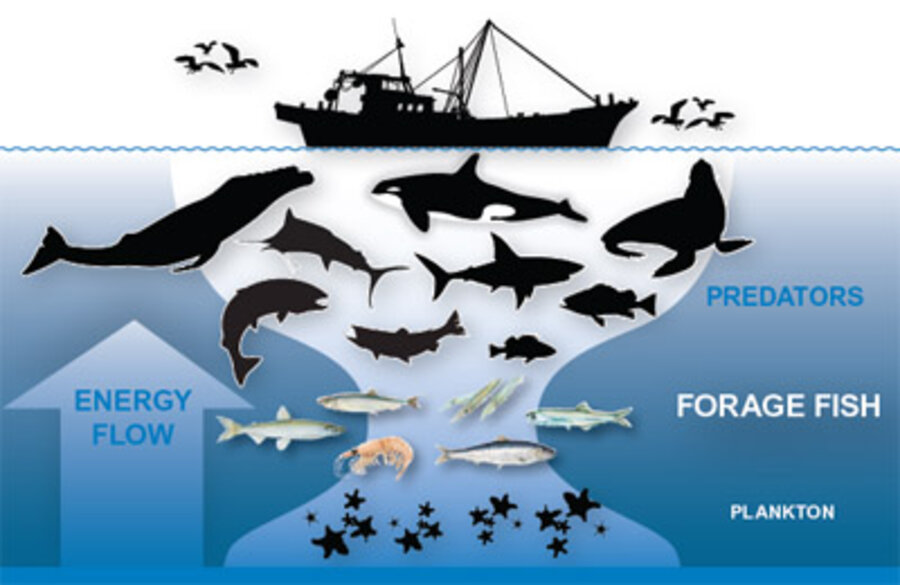Ocean's little fish are a big deal
Loading...
| Portland, Ore.
When people think of a healthy ocean, the first thing that comes to mind is usually a large iconic animal, perhaps a humpback whale leaping majestically out of the water or a pelican swooping low across the ocean surface. In my case, I’m hooked by the thrill of a big salmon as it pulls the line off my reel.
All of these animals dine on vast schools of tightly packed prey fish, commonly referred to as forage fish. Scientists and fishermen are becoming increasingly aware of their singular importance as the fuel that drives productive coastal ecosystems. At the same time, global demand is growing to catch forage fish for secondary purposes such as chicken feed, fertilizer, and bait for industrial longline fishing overseas.
But catching too many of these forage fish can severely disrupt the ocean life that they sustain. A lack of forage fish can have serious repercussions – especially for the fishing industry. Without little fish, there can be no big fish.
That’s why many fishing and conservation organizations – including The Pew Charitable Trusts – are rightly advocating for new measures to safeguard forage fish. The Pacific Fishery Management Council, which is responsible for managing marine fish on the West Coast, will have the opportunity to adopt some of these safeguards as it meets in Garden Grove, Calif., this week.
At the meeting, these West coast fishery leaders should decide to prohibit new commercial fishing on saury – a key forage fish – until it can be shown that it won’t harm bigger fish, whales, and seabirds that depend on saury as a food source. Doing so will enable the council to ask important questions before US forage fishing begins rather than waiting until industrial-scale fishing boats are catching these important fish.
Internationally, these forage fish – including sardines, anchovies, and saury – already account for more than a third of the total catch of wild marine fish, with 90 percent of it processed into fish meal or oil.
To its credit, the council unanimously adopted a fishery ecosystem plan that begins to consider how everything is connected in the ocean. The plan’s top priority is to make sure that no new fishing begins on forage species without first evaluating the effect on the larger ecosystem and on other predator fish such as salmon, tuna, and lingcod.
Forage fish eat tiny plants and animals drifting on the ocean’s surface and, in turn, become a crucial food source for whales, seabirds, and bigger fish. Diminishing forage fish populations can have serious consequences for the larger ecosystem. Just this year, wildlife rehabilitation centers in California have treated more than 1,500 emaciated and dehydrated sea lion pups at a time when prey fish were scarce.
Pacific saury is exactly the type of currently un-fished forage species that the council’s new ecosystem plan intends to protect. This dart-shaped fish makes up as much as 78 percent of the diet of the sooty shearwater, a type of seabird that is now arriving by the millions along the California shore from breeding grounds near Chile and New Zealand.
We know that saury is already extensively fished elsewhere around the world, and its relatively high abundance makes it a potential target for fishermen here on the West Coast. As it stands, fishing could begin on saury at any time with no restrictions – and no consideration of how it would affect predators. That would be a mistake. It is one the Pacific Fishery Management Council can – and should – avoid by approving restrictions on forage fishing at its meeting this week.
In April, the Pacific fishery council’s chairman cited the strong public testimony of the seafood industry, birding community, scientists, and fishermen in adopting a meaningful ecosystem plan. Protecting saury would help to maintain a productive ocean along the Pacific coast while demonstrating that regional fishery managers are serious about moving ecosystem-based management from theory into practice.
Some may wonder why we should act now. After all, no one on the West Coast is currently fishing for forage fish like Pacific saury, sandlance, or various kinds of smelts. To answer this concern, it’s worth looking north to Alaska. North Pacific fishery managers proactively protected dozens of unfished forage species more than a decade ago with the strong support of commercial fishermen. As one industry organization noted at the time, fishing for predators and their prey is akin to burning a candle at both ends.
I've been fishing almost as long as I can remember. Yet the thrill of being out on the water with friends, and the rush when a salmon or tuna bends my fishing rod, will never grow old.
It’s time for regional managers on the Pacific coast and elsewhere in the country to acknowledge what those of us on the water already know: Little fish are a big deal. It’s time to protect them.
Paul Shively works to conserve West coast forage fish as manager of the Pacific Fish Conservation Program at The Pew Charitable Trusts. He is a lifelong angler.





